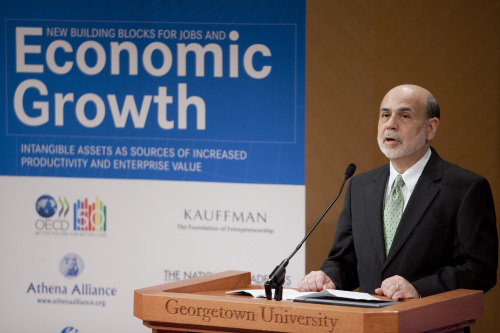Fed minutes reveal debate in April how to tighten credit if inflation persists
WASHINGTON (AP) ― The Federal Reserve said last month that the economy is gradually improving and began discussing how it would reverse policies adopted during the recession that pumped billions of dollars into the economy.
Some members said the Fed might need to start boosting interest rates this year to guard against inflation. Any effort to tighten credit would lead to higher rates on some mortgages, credit cards and other consumer loans.
Fed policymakers didn’t commit to taking any action at the April 26-27 meeting, according to minutes released Wednesday. But they agreed that if the economy continued its steady growth, the Fed would need to pull back on its massive stimulus programs and take steps to prevent consumer prices from getting out of control.
WASHINGTON (AP) ― The Federal Reserve said last month that the economy is gradually improving and began discussing how it would reverse policies adopted during the recession that pumped billions of dollars into the economy.
Some members said the Fed might need to start boosting interest rates this year to guard against inflation. Any effort to tighten credit would lead to higher rates on some mortgages, credit cards and other consumer loans.
Fed policymakers didn’t commit to taking any action at the April 26-27 meeting, according to minutes released Wednesday. But they agreed that if the economy continued its steady growth, the Fed would need to pull back on its massive stimulus programs and take steps to prevent consumer prices from getting out of control.

The officials generally agreed that the first step should be for the central bank to stop reinvesting money earned off its holdings of mortgages and Treasury securities. That’s consistent with comments made by Federal Reserve Chairman Ben Bernanke at a news conference after the April 27 meeting. But that would have only a limited impact on the rates Americans pay on loans.
A majority of participants said the best method for tightening credit would be to lift the federal funds rate, which is now at a record-low near zero. The federal funds rate is the interest banks pay each other on overnight loans. Most Fed officials said they preferred raising that rate before selling mortgage securities from the Fed’s vast portfolio.
Some members thought the Fed would need to start signaling to investors that interest rates would need to rise. A few members believed the Fed might need to boost its key interest rate or start selling some of the assets in its portfolio this year.
The minutes don’t identify what the individual Fed policymakers said.
Economist Chris Rupkey at Bank of Tokyo-Mitsubishi UFJ said the Fed could start boosting interest rates near the end of this year. Fed policymakers “are back to talking exit strategy,” he said. But high unemployment at 9 percent could weigh on the economy and delay any tightening into next year, he added.
The Fed’s exit strategy is likely to be more complicated than ever before because of the extraordinary steps the Fed took during and after the recession to prop up the economy.
The Fed’s balance sheet has nearly tripled in the past three years to roughly $2.7 trillion. To counter the 2008 financial crisis and the recession, the Fed launched programs to buy billions of dollars’ worth of mortgage securities and Treasury debt.
Those programs have helped drive down rates on mortgages and other loans and boosted stock prices. However, critics ― including some members of the Fed ― said the programs also contributed to higher inflation.
Many Fed officials said they preferred a gradual process of selling off its mortgage securities. The goal would be for the Fed’s portfolio to consist entirely of Treasury securities within five years of the start of those sales.
Fed officials didn’t agree on when the central bank would launch its exit strategy.
Bernanke and other Fed officials have predicted that a surge in oil prices would be temporary and would not lead to runaway inflation. Crude has fallen about 11.5 percent since April, when a weak dollar and a rash of international crises pushed oil to two-year highs.
Still, many Fed officials had become more concerned about inflation, the minutes revealed. They worried that oil prices could keep rising and force more companies to boost the prices they charge consumers. Fed officials said they need to monitor inflation closely.
Fed officials also expressed concerns that higher gas prices could lead consumers to spend less on discretionary goods, which would weigh on the economy. They also cited other risks that could restrain U.S. growth, including debt problems in Europe, supply disruptions to U.S. companies stemming from the earthquake in Japan and a failure by Congress to boost the U.S. government’s borrowing authority.
However, some Fed officials said there would need to be a “significant change” in the economic outlook for the Fed to embark on a third Treasury bond-buying program. The Fed is slated to end a $600 billion bond-purchase program on schedule in June.
The program was launched in early November when the Fed feared that the economy could ball back into another recession.
This isn’t the first time the Fed has talked about an exit strategy. Bernanke in February last year started laying out a plan about how the Fed would tighten credit when the time was right.
But the economy slowed sharply in the spring of 2011 because of the European debt crisis. And, unemployment got stuck at high levels topping 9.5 percent. By November, the Fed was forced to launch a second stimulus program.









![[Kim Seong-kon] Democracy and the future of South Korea](http://res.heraldm.com/phpwas/restmb_idxmake.php?idx=644&simg=/content/image/2024/04/16/20240416050802_0.jpg&u=)







![[KH Explains] Hyundai's full hybrid edge to pay off amid slow transition to pure EVs](http://res.heraldm.com/phpwas/restmb_idxmake.php?idx=652&simg=/content/image/2024/04/18/20240418050645_0.jpg&u=20240418181020)

![[Today’s K-pop] Zico drops snippet of collaboration with Jennie](http://res.heraldm.com/phpwas/restmb_idxmake.php?idx=642&simg=/content/image/2024/04/18/20240418050702_0.jpg&u=)